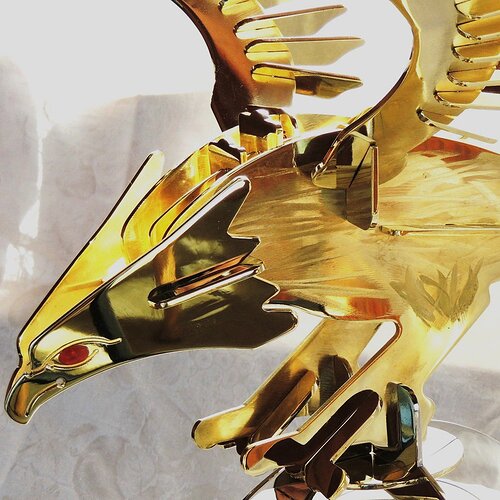Materials: Sheet commercial brass 2CU+ZN 59+41
Dimensions: 2 feet tall x 2 feet wide x 2 feet deep
4 mm thick sheet brass water jet cut eagle. Eagle is made up of 78 individual pieces that were polished using my cold metal burnishing,coloring and polishing technique. The brass atomic structure is similar to the French brass formula. My goal was to bring out the red into red brown and put the zinc into a high super white glass polish. Average temperature of the brass was 45 degrees F throughout the whole project.Each piece was handled 4 times with a different grease compound for each step-wheel speed was maintained at 3450rpm except for the zinc polish which was done using a 10" 4 weave 1 " soft cotton flannel buff-the addition of the 10" wheel buff slowed the speed to 2800 rpm. What was accomplished:
Reds and browns became pronounced and produced a deep yellow between.
The zinc maybe got a little to bright as all angles of the piece reflect everything from everywhere.
No acids, stains or enamels where used in order to justify the hidden colors within the brass.
Photo credit: Mark Moore
Mark Moore
Markus Minerals
Raytown, Missouri. USA
I always keep in mind that I am older than yesterday but still younger than tomorrow. Always amazed at the greatist artist that everyone throughout history has seen-and my inspiration-our PLANET EARTH- with that I am humbled. My background is in the construction industry and have always been around metals so being semi retired I taught myself how to work with silver-the rest is history.
The exhibition explores metal works whose primary theme is color embraced as their primary visual focus, whether that be using colored materials, exploring creating colored surfaces, or encasing the object in color.
As the world's largest jewelry related internet site, Ganoksin strives to develop exhibitions showcasing work from around the world. This exhibition was open to all metalsmiths, professional and amateur, advanced and beginner.
In total 303 artists contributed 814 show pieces for the permanent online exhibition.
The exhibition was curated by Beth Wicker, President of the North Carolina Society of Goldsmiths in the United States, and Adjunct Instructor at Northeastern Technical College in South Carolina. Director of the exhibition is Hanuman Aspler, founder of The Ganoksin Project, the world's largest internet jewelry site.
Hue is one of the primary properties of color, it refers to the place the color occupies on the visual spectrum. Humans have used hues throughout time, to create cave paintings, to decorate themselves, their clothing and their housing.
Different hues have taken on different meanings throughout time. Gold traditionally has been a color of purity - the metal gold is relatively unchangeable, and the hue of gold has come to stand for gods and goddesses, for royalty, for durability and for purity. Red has often meant love, or passion. Hues often reflect the meaning of the seasons, with pastels referring to spring and the burst of new life after the pale hues of winter. Summer is reflected in vibrant, deep hues, followed by the browning of hues in the fall as plants go to seed and die, and the land turns fallow.
The worth of a hue has often been tied to what is necessary to make the pigment that creates the hue, and the expensive involved in the process. Often created from crushed stones that had to be mined and carried by caravan over thousands of miles, or from fermented roots of plants only grown in certain areas, or the carapaces of rare insects - the creation of hue in a way that could be used by man was an involved and generally expensive process.
In today's world metalsmiths have access to perhaps the widest range of materials and hues in the history of man - and in some of the most affordable ways ever.
This exhibition celebrates hue - color - as an integral, inherent element of the work. We talk of the "richness" of color, and examples of this abound here. One expects hues from the colors of gemstones used in metalsmithing, but we also have hues from some less expected places. Glass enamels are an ancient way of adding color, as are a variety of patinas. Today's artists also use synthetic man-made materials to add color in ways that didn't exist a century ago.
We invite you to enjoy this celebration of hue, and the ways hues and their use have changed over time.
